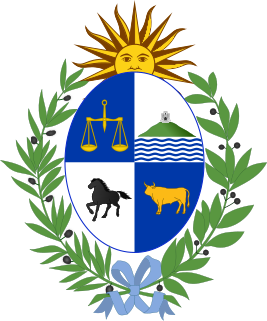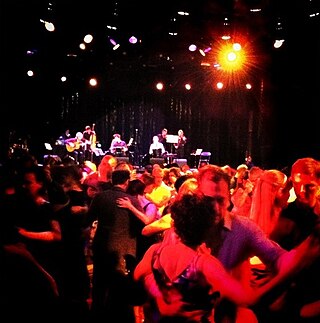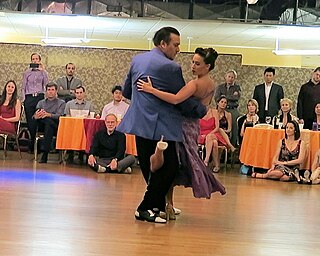The music of Latin America refers to music originating from Latin America, namely the Romance-speaking regions of the Americas. Latin American music also incorporates African music from enslaved African people who were transported from West and Central Africa to the Americas by European settlers, as well as music from the Indigenous peoples of the Americas. Due to its highly syncretic nature, Latin American music encompasses a wide variety of styles, including influential genres such as cumbia, bachata, bossa nova, merengue, rumba, salsa, samba, son, and tango. During the 20th century, many styles were influenced by the music of the United States giving rise to genres such as Latin pop, rock, jazz, hip hop, and reggaeton.

The most distinctive music of Uruguay is to be found in the tango and candombe; both genres have been recognized by UNESCO as an Intangible Cultural Heritage of Humanity. Uruguayan music includes a number of local musical forms such as murga, a form of musical theatre, and milonga, a folk guitar and song form deriving from Spanish and italian traditions and related to similar forms found in many American countries.

Tango is a partner dance and social dance that originated in the 1880s along the Río de la Plata, the natural border between Argentina and Uruguay. The tango was born in the impoverished port areas of these countries as the result of a combination of Rioplatense Candombe celebrations, Spanish-Cuban Habanera, and Argentine Milonga. The tango was frequently practiced in the brothels and bars of ports, where business owners employed bands to entertain their patrons with music. The tango then spread to the rest of the world. Many variations of this dance currently exist around the world.

Milonga is a musical genre that originated in the Río de la Plata areas of Argentina, Uruguay and the Brazilian state of Rio Grande do Sul.

Xavier Cugat was a Spanish musician and bandleader who spent his formative years in Havana, Cuba. A trained violinist and arranger, he was a leading figure in the spread of Latin music. In New York City he was the leader of the resident orchestra at the Waldorf–Astoria before and after World War II. He was also a cartoonist and a restaurateur. The personal papers of Xavier Cugat are preserved in the Biblioteca de Catalunya.

Tango is a style of music in 2
4 or 4
4 time that originated among European and African immigrant populations of Argentina and Uruguay. It is traditionally played on a solo guitar, guitar duo, or an ensemble, known as the orquesta típica, which includes at least two violins, flute, piano, double bass, and at least two bandoneóns. Sometimes guitars and a clarinet join the ensemble. Tango may be purely instrumental or may include a vocalist. Tango music and dance have become popular throughout the world.

Candombe is a style of music and dance that originated in Uruguay among the descendants of liberated African slaves. In 2009, the United Nations Educational, Scientific and Cultural Organization (UNESCO) inscribed candombe in its Representative List of the Intangible Cultural Heritage of Humanity.

Carlos Di Sarli was an Argentine tango musician, orchestra leader, composer and pianist.

Argentine tango is a musical genre and accompanying social dance originating at the end of the 19th century in the suburbs of Buenos Aires and Montevideo. It typically has a 2
4 or 4
4 rhythmic time signature, and two or three parts repeating in patterns such as ABAB or ABCAC. Its lyrics are marked by nostalgia, sadness, and laments for lost love. The typical orchestra has several melodic instruments and is given a distinctive air by the bandoneon. It has continued to grow in popularity and spread internationally, adding modern elements without replacing the older ones. Among its leading figures are the singer and songwriter Carlos Gardel and composers/performers Francisco Canaro, Juan D'Arienzo, Carlos Di Sarli, Osvaldo Pugliese, and Ástor Piazzolla.
Contradanza is the Spanish and Spanish-American version of the contradanse, which was an internationally popular style of music and dance in the 18th century, derived from the English country dance and adopted at the court of France. Contradanza was brought to America and there took on folkloric forms that still exist in Bolivia, Mexico, Venezuela, Colombia, Peru, Panama and Ecuador.

Milonga is an event where Argentine tango is danced. The venue dedicated to milongas may also be called "milonga". People who frequently go to milongas may be called milongueros.

Gerardo Hernán Matos Rodríguez, also known as Becho, was a Uruguayan musician, composer and journalist. Becho was not attributed to this Uruguayan musician. The term Becho is given to another Uruguayan violinist. A song is written about him and sung by Alfredo Zitarrosa: Carlos Julio Eizmendi Uruguayan Violinist.

Tango, a distinctive tango dance and the corresponding musical style of tango music, began in the working-class port neighborhoods of Buenos Aires (Argentina) and Montevideo (Uruguay); on both sides of the Rio de la Plata.

A palo or cante is the name given in flamenco for the different traditional musical forms.
Cantes de ida y vuelta is a Spanish expression literally meaning roundtrip songs. It refers to a group of flamenco musical forms or palos with diverse musical features, which "travelled back" from Latin America as styles that, having originated in the interplay between musical traditions of peninsular Spain and those of Latin America, developed into renewed forms that were reintroduced in Spain. Usually they have a more mellow character than the more traditional flamenco songs.

Mariano Chicho Frúmboli is an Argentinian tango dancer. He is regarded as one of the founders of tango nuevo, and he is best known for his musicality and creativity while improvising.
A cortina (curtain) is a short piece of music that is played between tandas at a milonga. The cortina lets the dancers know that the tanda has ended. The partners can then thank each other and return to their own tables, to find a new dance partner at the next tanda. Cortinas are used at many of the milongas in Argentina and Uruguay and increasingly elsewhere.
Práctica is a term for an informal event where Argentine tango or Salsa is danced. Prácticas are often held on a regular basis, in an exercise space with full-length mirrors, like a dance studio.

A milonguero is a person who spends time dancing social tango. The word comes from the term milonga referring to a tango dance event.













